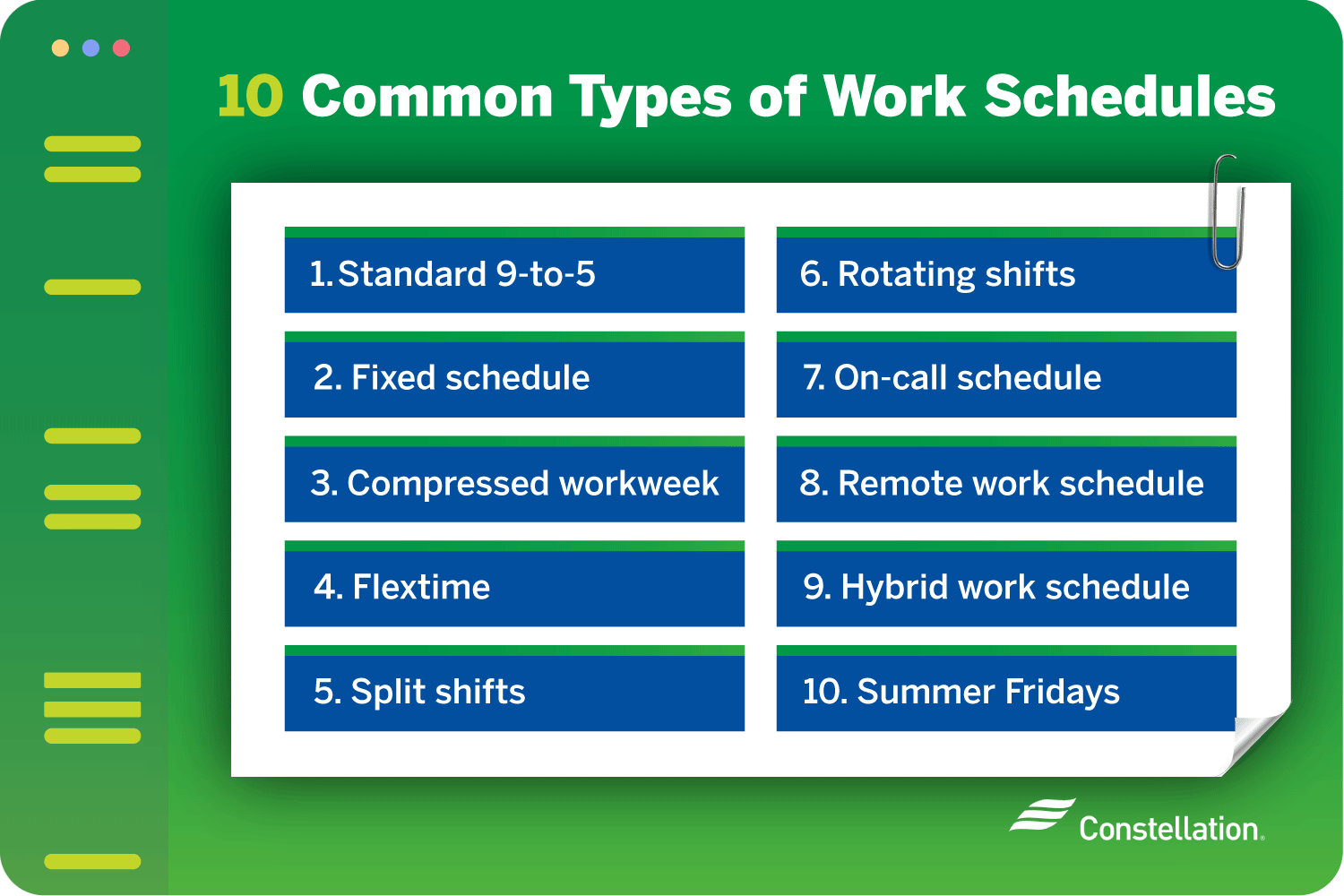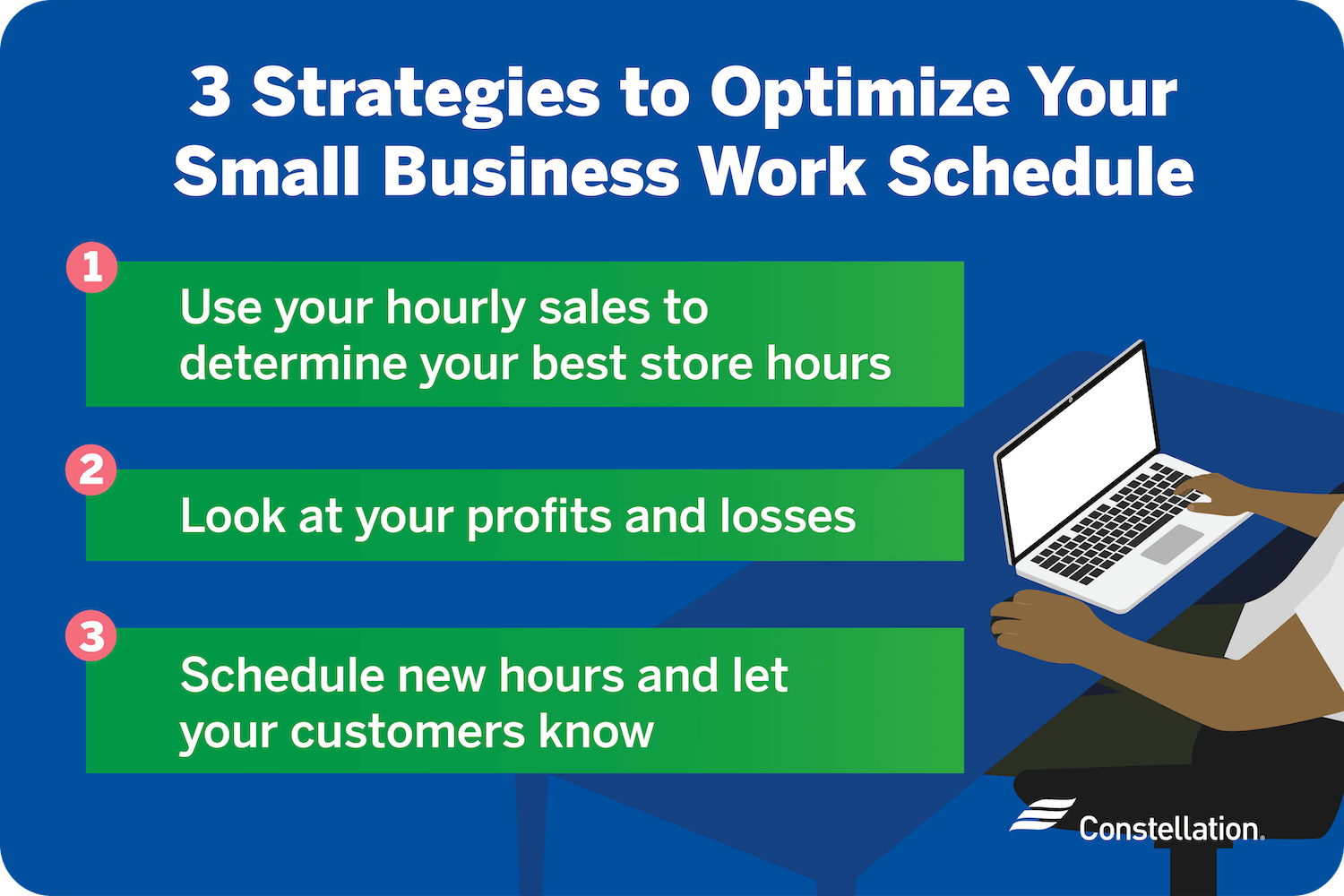
- Category:
Small Business Energy Savings -
Last updated:
February 6, 2025
Work Schedule Ideas and Energy Saving Tips
Implementing a few flexible work schedule ideas may help you reduce your variable costs. While you have little control over your fixed costs—you pay the same amount of rent whether you’re open 24/7 or keep more limited business hours—varying types of work schedules can help you control variable costs, such as labor and energy usage. Both of these are directly tied to your working hours.
Advances in technology and changing cultural norms are breaking the boundaries of the traditional 9-to-5 workday. Many employers are seeing the benefit of offering an alternative work schedule or a more flexible work arrangement. Whether offering a shorter workweek or assigning some people to work remotely, you may be able to reduce your business’ energy consumption.
10 types of work schedules
The amount of energy your business consumes is directly tied to occupancy. You use more energy when people are at work in your facilities. Different types of work schedules change the number of people physically working onsite and how long they work there, both of which affect your energy usage.
Here are alternative work schedules and types of flexible work arrangements with a discussion of their pros, cons and impact on your energy usage. You can then explore the best business hours for your company.
1. Standard 9-to-5
This traditional approach has workers scheduled Monday through Friday, starting at 9 in the morning and leaving at 5 in the afternoon. It offers predictability, with all workers on the same schedule to facilitate meetings and collaboration.
On the negative side, employees have little flexibility for chores, errands and personal issues. It leads to traffic congestion, as everyone rushes to work and to home at the same time. For companies that work around the clock, this schedule is not a good fit.
2. Fixed schedule
A variation of the 9-to-5 routine is to schedule workers according to a fixed schedule that may start earlier and end earlier, or start later and end later. It offers the same benefits as the 9-to-5 option, but relieves the commuter rush hour.
It can interfere with work-life balance, however, as your workers may need to be on the job when peers are enjoying an evening out. If you run night shifts, it may create health problems for workers, with disrupted sleep that increases health risks. As an energy savings tactic, you may be able to schedule more work during off-peak hours when energy prices are lowest.
3. Compressed workweek
With this schedule, your employees put in full-time hours, but they do it in fewer, longer days. They may work four 10-hour days, for example. The extra day off gives workers time for family, chores and personal business. You avoid rush hour commutes. You may also save energy with an empty building one more day a week. On the downside, not every business can afford to shut down for a full extra day. And longer days are not necessarily more productive.
4. Flextime
This schedule puts employees in control of choosing their own schedule. You can offer them a range of days and hours, and then they make their choices. Employees can maximize work-life balance, avoid crowded commutes and lower stress. This approach may lead to higher productivity. The cons, however, are significant.
Varying schedules can be difficult to manage and collaboration is a challenge. Customer care may suffer and meeting deadlines can be challenging, depending on your industry. You may end up spending more on energy if flextime leads to your buildings being occupied for longer periods of the day.
5. Split shifts
You can divide your workday into chunks or shifts. For example, starting at 7 a.m. and working until 11 a.m., then taking a break and running from 4 p.m. to 8 p.m. If your work has rush times, like a restaurant, this approach is very efficient. It also gives employees time in the day for their personal business.
If employees travel far, they may have to commute twice, burning more energy. And you may end up using more energy if you don’t fully shut down your building between shifts.

6. Rotating shifts
With this approach, you assign work on different schedules that change by the week or month. You can assign undesirable shifts on a rotating basis, so no one gets stuck. You can give employees experience in different work conditions, as you cover operations for continuity. Offering higher pay for some shifts can incentivize employees.
Downsides include disrupted sleep and the fact that a constantly changing schedule creates family chaos. You’ll still have your buildings open and using energy, so you won’t see savings there.
7. On-call schedule
For worksites with a highly variable workload, a work-as-needed approach gives you and your employees maximum flexibility. On the downside, workers may struggle without a schedule around which to plan. Work-life disruption and stress can result. You will still need to keep operations open, so you won’t see energy savings.
8. Remote work schedule
When it comes to reducing energy use and capitalizing on flexible schedule benefits, businesses that operate with remote workers have an advantage. Saving energy in the workplace is easier if your employees work from home.
The more employees are present in your workplace, the more energy you need to keep the business up and running. The energy to run computers, keep the lights on and maintain a comfortable temperature are part of an employee maintaining their home. The employee absorbs those costs at home for the chance to work outside the office.
Employees also don’t burn time and energy commuting. While collaboration can be challenging and you will have to keep an eye on productivity, the benefits of working remotely are why it’s recognized as one of the most important emerging small business technology trends.
9. Hybrid work schedule
A hybrid work schedule combines onsite work with remote work. This is one of the flexible work schedule ideas that seeks to reap the benefits of remote work, including energy savings, along with the benefits of time onsite. The more often you allow your employees to work from home, the more you’ll be able to save on energy costs. However, coordination of schedules remains a challenge with this approach, and tracking productivity is particularly important.
10. Summer Fridays
Employee productivity typically drops during the summer months: According to Forbes, about 36% of U.S. workers admit to being less productive during the summer. The problem is especially pronounced on Fridays, when everyone is anticipating the weekend.
A summer Fridays policy is a way of acknowledging this problem by allowing employees to clock out earlier on Fridays or even take the entire day off. While it seems counterintuitive, the system yields several flexible schedule benefits. Worker morale is higher, and they’re more likely to be productive during the rest of the week in order to “earn” their early Friday clock-outs. Since employees will be spending less time in the workplace, you’ll also be able to conserve energy and reduce HVAC expenses.
Which type of work schedule is best for saving energy?
Of the types of work schedules, you won’t find one that is best across every situation. Flexible work arrangements need to fit your type of business, workflows, and corporate culture. You might experiment with several examples of flexible working hours to find the one that best fits.
For saving energy, the types of work schedules that help you cut power usage are those that move activities out of peak energy usage hours, those that shorten your workweek and those that move more people offsite.
Tips for optimizing your small business’ work schedule
These flexible working hour examples may increase your return on investment (ROI). You may be able to trim your energy budget and increase productivity at the same time. Below are a few ways you can maximize the ROI of your flexible work arrangements.

1. Use your hourly sales to determine your best store hours
If you have a point-of-sale (POS) system, use it to generate a data-based report of your daily and hourly sales. The report will show which times of day are busiest and most profitable. You can schedule your operating hours and worker schedules accordingly.
2. Look at your profits and losses
You can also look at your business’ profit and loss statement. Use the report to compare your revenue to costs by day of the week. Watch for times when your average sales fail to cover the cost of labor and energy use. Such times could indicate the need for a change in your work schedule.
3. Schedule new hours and let your customers know
When you create a new business schedule, you should alert your customers to the new schedule ahead of time. Small businesses should keep their hours relatively consistent to make the new schedule easy to remember.
Finding the right schedule for your business
In considering flexible work schedule ideas, the ones that are most ideal for your business are those that serve your customers, the needs of your business and the preferences of your employees. What you do, how your team works and what customers expect are key drivers.
Saving energy and controlling costs are possible with the right types of work schedules. Alternative work schedules can contribute to your business sustainability plan, helping you reduce energy consumption while maximizing employee productivity. When used correctly and creatively, a flexible work schedule is better for your bottom line, your employees’ work-life balance and the environment.




